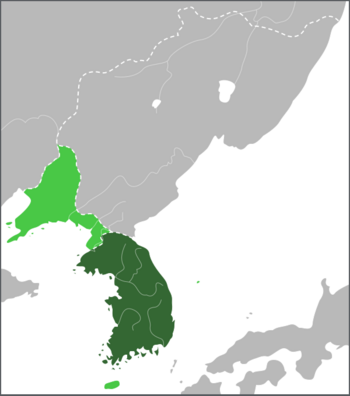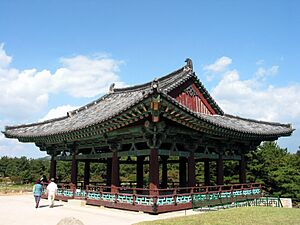Unified Silla facts for kids
Quick facts for kids
Unified Silla
|
|||||||||||||||
|---|---|---|---|---|---|---|---|---|---|---|---|---|---|---|---|
| 668–935 | |||||||||||||||

Map showing the territory of Unified Silla.
|
|||||||||||||||
| Status | Kingdom | ||||||||||||||
| Capital | Seorabeol | ||||||||||||||
| Common languages | Old Korean Classical Chinese, (literary) |
||||||||||||||
| Religion | Buddhism (state religion), Confucianism, Taoism, Islam, Shamanism |
||||||||||||||
| Government | Monarchy | ||||||||||||||
| King | |||||||||||||||
|
• 661–681
|
Munmu | ||||||||||||||
|
• 681–692
|
Sinmun | ||||||||||||||
|
• 887–897
|
Jinseong | ||||||||||||||
| Historical era | Post-classical | ||||||||||||||
| 668 | |||||||||||||||
|
• Silla–Tang War
|
670–676 | ||||||||||||||
|
• Start of Later Three Kingdoms period
|
892–936 | ||||||||||||||
|
• Handover to the Goryeo
|
935 | ||||||||||||||
| Population | |||||||||||||||
|
• 8th century
|
2,000,000 | ||||||||||||||
|
|||||||||||||||
| Today part of | North Korea South Korea |
||||||||||||||
| Unified Silla | |

Anapji pavilion
|
|
| Korean name | |
|---|---|
| Hunminjeongeum | |
| Hanja | |
| Revised Romanization | Tongil Silla |
| McCune–Reischauer | T'ongil Shilla |
Unified Silla (Korean: 통일신라; Hanja: 統一新羅; RR: Tongilsilla) was a powerful kingdom in ancient Korea. It began in 668 CE when the Silla kingdom united parts of the Korean peninsula. Silla worked with the Tang dynasty of China to conquer the kingdoms of Baekje and Goguryeo. This led to Silla controlling the central and southern areas of Korea.
Unified Silla lasted for 267 years. It was a time of great cultural growth. The kingdom ended in 935 CE when its last king, King Gyeongsun, gave up his rule to the new Goryeo kingdom.
Contents
What Does "Unified Silla" Mean?
The name "Unified Silla" shows that the kingdom brought together different parts of Korea. Historians in South Korea often see it as the first time the Korean people were united.
However, some historians, especially in North Korea, use the term "Late Silla." They argue that Silla did not truly unite all of Korea. This is because a kingdom called Balhae existed in the north at the same time. Balhae also controlled Korean territory.
The people of Silla, however, believed they had united the three kingdoms of Korea. They called this "삼한일통" (Samhaniltong). This means "unifying the three Han (Korean) states." King Munmu and later kings worked to bring the people together. For example, King Sinmun divided the country into nine regions. He also gave important positions to nobles from the conquered kingdoms.
A Look at Unified Silla's History
How Silla United Korea
In 660 CE, King Munmu of Silla ordered his army to attack Baekje. General Kim Yu-sin, with help from Tang forces, defeated Baekje's General Gyebaek. This led to Baekje being conquered.
Silla then tried to conquer Goguryeo in 661 CE but was not successful at first. After this, Silla fought against the Tang dynasty for almost ten years. Silla eventually won these battles. This allowed Silla to control the southern part of Goguryeo.
Challenges and Changes
Unified Silla faced challenges, especially from rebel groups in the newly conquered areas. These groups caused political problems. This eventually led to a period known as the Later Three Kingdoms in the late 9th century.
The capital city of Silla was Seorabeol, which is now Gyeongju. It remained the capital throughout the dynasty. This shows how strong Silla's government system was. The "Bone Clan Class" system helped a small group of powerful families rule over many people.
A Prosperous Kingdom
Despite some political issues, Unified Silla was a very successful country. Its capital, Seorabeol, was one of the largest cities in the world at that time. Silla had strong connections with the Tang dynasty in China.
During this period, Buddhism and Confucianism became very important. These ideas influenced the art and buildings of the time. The last king, Gyeongsun, gave up his rule to Wang Geon of the rising Goryeo kingdom in 935 CE. This marked the end of the Silla dynasty.
Culture and Innovations
Unified Silla was a golden age for art and culture. Famous examples include the Hwangnyongsa temple, the Seokguram grotto, and the Emille Bell. Buddhism was very popular. Many Korean Buddhist monks traveled to China and even India to study. They brought back new ideas and different types of Buddhism, like Seon.
Trade and Communities
Silla was also strong in sea trade. Like the ancient Phoenicians, Silla sailors controlled the seas of East Asia. They traded between China, Korea, and Japan. A famous figure from this time was Jang Bogo. Silla people even set up communities in China, especially on the Shandong Peninsula.
Learning and Science
Unified Silla had a national Confucian college. It was set up in 682 CE. This college was mainly for the children of the elite families.
The kingdom was also advanced in science and technology. They paid close attention to astrology, which was important for farming. This helped them accurately record events like solar and lunar eclipses.
Early Printing Technology
Woodblock printing was used to make copies of Buddhist texts and Confucian writings. An amazing discovery was made during repairs to a pagoda called "Pagoda That Casts No Shadows." An ancient print of a Buddhist text was found. This print is from 751 CE. It is one of the oldest printed materials ever discovered in the world!
See also

